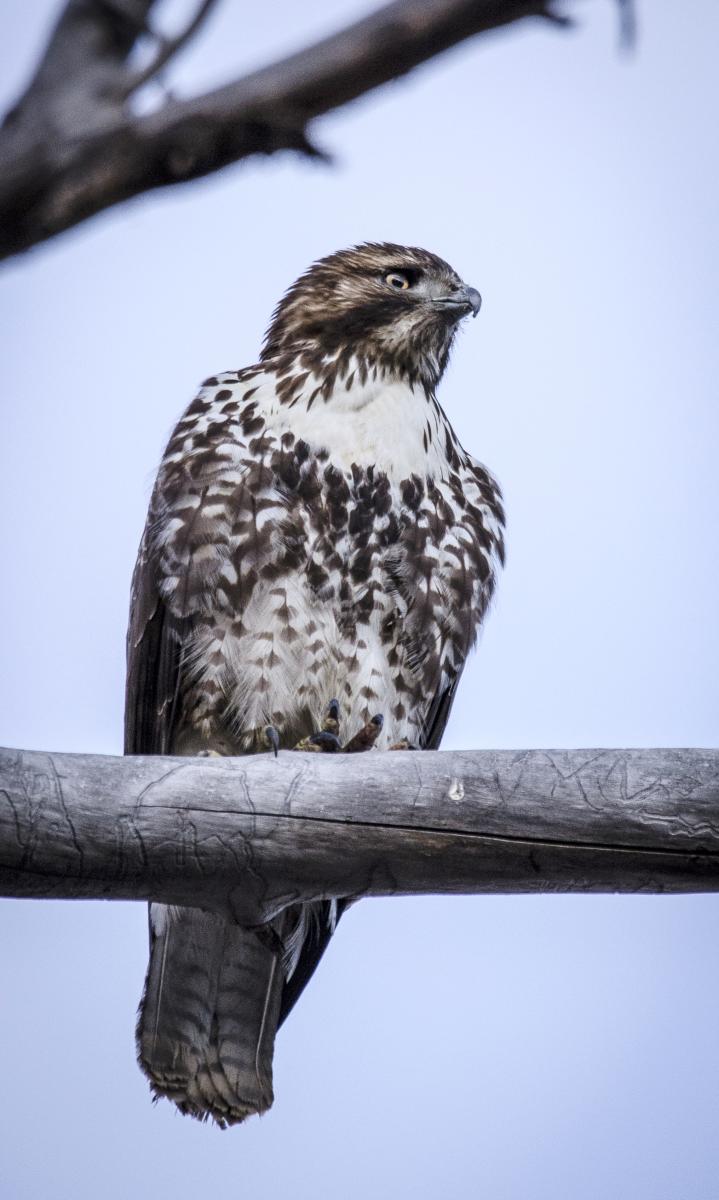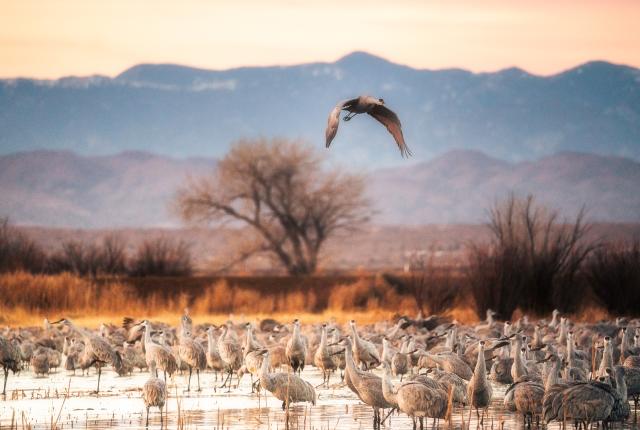Each winter, sandhill cranes draw thousands of photographers, birders, and interested folks to the Bosque del Apache National Wildlife Refuge. Photograph by Aaron Blanc.
EARLY LAST SEPTEMBER, I walked up from the wetlands at Río Fernando Park and onto the streets of Taos. I’d passed the afternoon photographing a pair of Cooper’s hawks and a massive great horned owl along the banks of the little creek that cuts through the center of town.
The hawks didn’t seem to mind. The male glanced my way, then returned his focus to the grassy bank of the creek, where, I was sure, he’d spotted dinner. I held my breath, waiting for the bird to pounce. He did, falling in a rush of brown and white into the grasses and lifting just as quickly to a scrag of Russian olive, where he dined on a plump mouse.
The owl seemed irritated. He glowered, flew to a cottonwood, and tucked himself between two massive limbs. He closed one of his enormous yellow eyes, while the other stayed focused on me.
I made my way among the willows. A deep, rich refuge of mostly native trees, flowers, and wildlife, the recently restored wetlands provide a refuge from urban life. For me, making pictures of birds is less about the photos and more a reason to be outside, breathe deeply, look closely, and tap into all my senses.
I was still in that reverie when I emerged onto the street and my eye caught a flash of olive green at the base of a bush next to the road. A MacGillivray’s warbler huddled in the foliage. I saw another one. And another. A Wilson’s warbler lay dead at the edge of an acequia. By the time I arrived home, I had counted dozens of dead birds, and hundreds more struggling to survive in the sprawl of weeds and brush along the roadway edges.
“Something bad is happening,” I said to my wife.
 Among New Mexico’s 500 species are great horned owls. Photograph by Christina Selby.
Among New Mexico’s 500 species are great horned owls. Photograph by Christina Selby.
WHEN IT COMES TO BIRDS, New Mexico is rich. More than 500 species live in or pass through our state each year, third only to California and Texas. This extraordinary diversity makes New Mexico one of the top spots in North America for bird-watching—the kind of place where enthusiasts complete checklists and add once-in-a-lifetime sightings like the southwestern willow flycatcher or Lewis’s woodpecker.
“It’s the variety of habitat that does it,” says Jon Hayes, executive director of Audubon Southwest. New Mexico has it all: snowcapped 13,000-foot peaks, rolling grasslands, forested mesas, jungle-like river bottoms, glistening lakes, and rolling desert dunes. The landscape diversity creates habitats rich with plant and animal species and a smorgasbord of food sources. That’s not all, says Hayes. “The way we are situated on the continent makes us a funnel for all sorts of migratory bird species.”
New Mexico is not some flyover state, a fact proved each winter as sandhill cranes, snow geese, and other waterfowl return to the Middle Río Grande Valley for a full-feathered display. The event, and its accompanying Festival of the Cranes, draws thousands of photographers, birders, and interested folks to the Bosque del Apache National Wildlife Refuge.
While it is difficult to quantify exactly how much bird-watching contributes to the state’s economy, it is significant, says Hayes. The U.S. Fish and Wildlife Service estimates that some 47 million Americans participate in bird-watching, contributing more than $41 billion in economic activity nationwide and supporting nearly 700,000 jobs. “Lots of those folks come to New Mexico every year,” he says.
New Mexico birds are under threat, however. In fact, bird populations are crashing worldwide. Tragically, few people other than active bird-watchers notice. For birders, it is impossible not to worry about the species’ future. And, with them, our own.
I’ve watched, recorded, and photographed New Mexico birds for almost two decades. Over the past five to seven years, I’ve noticed flocks are smaller, visitors to my yard are fewer, and birds are generally harder to find. Over the course of a week in mid-September, I found hundreds of dead birds in the Taos area. Hundreds more—weak, emaciated, and dehydrated—cowered in the brush. Hardly an isolated incident, the mass die-off occurred nearly statewide.
“Our birds are facing an uphill battle,” says Hayes.
Steve Knox, a retired Los Alamos National Laboratory physicist and Audubon Christmas Bird Count leader, points to many threats. The mass die-off of violet-green swallows in 2020 was attributed to starvation. “They rely on insects as a food source, and insect populations are crashing due to pesticide use,” Knox says. “This year also had an early cold snap that killed many insects.”
Urbanization and development, oil and gas operations, expanding farmland, buildings lit at night, and wind turbines also contribute to the deaths. Domestic cats are another challenge. “Your cute little kitty is also a brutal hunter,” says Knox.
But by far the largest problem facing New Mexico’s birds is climate change.
 Cedar waxwings can be spotted across the state. Photograph by Christina Selby.
Cedar waxwings can be spotted across the state. Photograph by Christina Selby.
“The underlying story here is drought and fire,” says Robert Templeton, a retired educator and avid birder from northern New Mexico. He points to the hermit thrush, a very secretive, medium-size bird with a melodic song that overwinters along the Río Embudo, south of Taos. “We’ve noticed some very unusual feeding habits this fall,” he says. “They were feeding in gardens and in trees, and they weren’t staying hidden.”
By mid-August last year, nearly 150,000 acres of land in Colorado were ablaze. A record 4.2 million acres of California also burned. As the migrating, insect-dependent birds headed south, they ran into burned-over habitat, says Templeton. “They didn’t have enough to eat.”
At the same time, an unusual dip in the jet stream blasted northern New Mexico with an early cold snap. The birds simply couldn’t handle all the hits.
“If a lack of food contributed to the mortality event, birds would have less fat and no protection against hypothermia,” wrote University of New Mexico researcher Jenna McCullough. “Indeed, of the hundreds of birds we assessed, none had fat stores on their bodies.”
New Mexico is warming and drying out. Our average annual temperature has increased by about 2.7 degrees Fahrenheit since the 1970s. Winter snowpack is declining, and summer monsoons aren’t delivering their former punch. Wildfire season has expanded from five to seven months, with blazes growing in size each year.
“One in four birds in the western hemisphere have simply disappeared over the last 50 years,” says Knox. “That’s three billion birds. In New Mexico, we’ve seen a steady decline in numbers.”
Populations of the piñon jay, for example, are struggling, he says. Estimates from the New Mexico Department of Game and Fish indicate a decline of 80 percent or more throughout the West over the past 50 years. “This impacts the landscape,” Knox says. The jay is the primary disperser of seeds for our iconic state tree. Fewer birds means fewer trees, which in turn means fewer birds, and so on.
According to the Audubon Society, more than 150 New Mexico birds are at risk of extinction due to climate change in the next 50 to 70 years. Alpine species are perhaps most at risk. As environmental conditions change, birds that depend on high-altitude ecosystems are forced to higher elevations. But they can move up for only so long. One of these mountain denizens, the brown-capped rosy finch, may have already stopped breeding in New Mexico, says Hayes.
Other species are on the move. Our state bird, the roadrunner, has hightailed it north and into higher elevations, as they warm. The white-winged dove and the common black hawk are both moving north through central New Mexico.
“The northern cardinal has started to show up in Taos,” says Chris Rustay, an eBird and Great Backyard Bird Count editor. “Chipping sparrows are overwintering as far north as Dixon.”

Juvenile red-tailed hawks often have brown tails with darker horizontal bars. Redtails tend to be stockier than other raptors. Photograph by Jim O'Donnell.
DESPITE ALL THIS BAD NEWS, A NORTHERN flicker creeps toward the feeder. He sees me, but I’m still and patient and gain his trust. Soon he is just a few feet away, pecking at the suet. His partner arrives, and I can hardly contain my excitement.
For millions of people, bird-watching is also a stepping-stone to something greater. If you’ve ever spent time simply observing a place that pulls you back again and again, you know what I mean. As you come to know the details of a place, you develop a sense of appreciation and understanding.
Art and science both tell us that nature in general offers calmness and renewal. Bird-watching can be a path into a different way of being with the world.
And it is fun. Getting in touch with our fellow animal passengers on this blue orb can be deeply satisfying. As you learn, a sense of accomplishment creeps into your outings. Plus, the birding community is full of friendly, thoughtful, and helpful people. Birding workshops, festivals, and meetups connect us to our world and to one another.
For more than a century, birders have made valuable contributions to our understanding of the world. Now, as bird populations struggle from a variety of threats, bird lovers can contribute more. We can protect the things we value.
“Get outside,” says Hayes. “Get outside and take a friend. Connect to nature, and then advocate for what you want to protect.”


